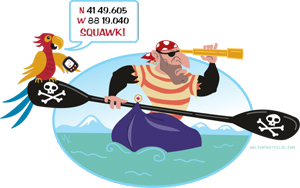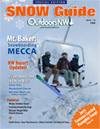Aquacaching 101

Aquacaching is to paddling as geocaching is to hiking
By Shiromi Arserio
Imagine sitting on the side of your kayak, bracing yourself for a dive into the water below. Once you get past the initial shock of the chilly water, you peer into the darkness, searching for anything unusual. Spotting a heavy chain that holds down a mysterious container, you find what you have been searching for.
Plunging into the murky water, you retrieve the carefully hidden booty. Finally, you’re back on the kayak opening up the plastic container to see what treasures lay within.
Aquacaching is an off-shoot of the popular treasure hunting sport, geocaching. In traditional geocaching, hikers hide containers filled with trinkets such as keychains or coins for others to find using GPS coordinates.
Aquacaching is to paddling as geocaching is to hiking. However, instead of being buried in the woods, caches are hidden close to or under water, requiring aquacachers to paddle or swim to the cache.
Local Aquacaches
Just over an hour north of Seattle is Lake McMurray which is home to a handful of aquacaches. Some are located along the shore close to the many trails that surround the lake, while others can only be reached by kayak. The 160-acre lake is a popular spot for rainbow trout fishing so be extra careful when retrieving your cache and make sure you aren’t spotted by non-aquacachers, known as muggles.
If you’re in Oregon’s Willamette Valley consider a trip to Ankeny National Wildlife Refuge, near Salem which houses a handful of water caches. The refuge was primarily created as a home for Dusky Canada Geese to spend their winters.
Paddling along the Santiam and Willamette rivers, you can find caches hidden away on islands inaccessible by land as well as others along the wetland trails. In addition to geese, keep an eye out for other water birds such as the Blue Heron that makes Ankeny Wildlife Refuge its home.
Another new aquacaching underwater game is put together by Divecaching.org. This organization is being promoted through local Northwest dive shops and is great for snorkelers or certified divers to seek out deeper underwater
caches.
Getting Started Aquacaching
Getting started aquacaching requires a GPS (Global Positioning Device) and a waterproof case to hold it. You will also need a kayak or canoe to get around. Some swimming can be involved so a snorkel, mask and fins are also a good idea.
With your equipment together, simply go online to get cache coordinates to input into your GPS. Don’t forget to also bring a few trinkets to throw in the cache.
Of course, trinkets are only a small part of the fun of aquacaching. The real treasure is that feeling of adventure: discovering new locales or looking at familiar places and knowing what secrets are hidden away. Even if you have visited Ankeny National Wildlife Refuge many times, imagine how different the experience is once you know what lies hidden by the river’s murky shores.
After finding a few aquacaches you may want to create your own. Simply get a waterproof container with a few trinkets to start. Don’t forget to include pen and waterproof paper so groups can log their find. Once you’ve hidden the cache, upload the coordinates to a site like geocaching.com.
Lake McMurray: From Seattle, follow I-5 North to exit 208. Take Highway 530 towards Arlington. At Arlington, turn left and follow Highway 9 North. Continue following for 10 miles. Take a left on Lakeside Lane and follow it until you reach Lake McMurray. For driving directions, Google Lake McMurray.
Ankeny National Wildlife Refuge: From Salem, follow I-5 South to exit 243 and take Ankeny Hill Road SE for 2.7 miles. Turn left at Buena Vista Road and continue for 0.8 miles until you reach the refuge. For driving directions, Google Ankeny National Wildlife Refuge.
Cache Box
www.geocaching.com – Premium members can click on “pocket query” and add attributes such as “swimming.”
www.aquacaching.org – Click “find a cache.”
Shiromi Arserio is a British freelance travel and outdoors writer currently residing in Lynnwood, Wash. Shiromi’s hobbies include hiking, geocaching, paddling and scuba diving.
Shopping for a GPS? Here are a few tips:
GPS units vary in both price points and features. Here are a few features to look for when shopping for a GPS for geocaching.
Screen: Typically, the larger the screen, the easier it is to read. Also, consider choosing a device with a transreflective screen which is easier for reading in bright sunlight.
Accuracy: To ensure your GPS receiver gets a good signal, look for a unit with a 12-channel receiver meaning that your GPS unit can receive signals from up to 12 different satellites at one time.
Ruggedness: A rubberized hard exterior will help keep the unit from breaking when dropped. For aquacaching, you will need a GPS with an IPX7 waterproof rating which means it can be dropped into one meter of water, for a maximum of 30 minutes without it being damaged.
Battery Life: Most new GPS units have rechargeable lithium ion batteries that last from 5 –16 hours, depending on usage. Some GPS devices also take standard AA batteries which is useful if you’ll be in the woods for several days with no way to recharge it.
Paperless Geoacaching: Paperless geocaching allows you to download cache information directly to your GPS, eliminating the need to jot down coordinates.
~S.A



